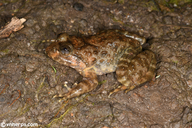|
Nanorana yunnanensis (Anderson, 1879)
Yunnan Spiny Frog | family: Dicroglossidae subfamily: Dicroglossinae genus: Nanorana |
 © 2020 Thanh Luan Nguyen (1 of 4)
|
|
|
|
Description The ventral surface of the female is smooth. Males have nuptial pads on the inner four toes, a pair of large nuptial pads on the chest, an inner vocal sack beneath the throat, but no male glands. Eggs are about 4mm in diameter, gray or black in color. The tadpoles are about 52mm in length, with head-body lengthabout 20mm. The dorsal is palm-brown in color, with scattered dark marks. The tale is light-palm color, with a dull tip. The labial tooth row is often I:4-4 / II:1-1. One row of lower labial papillae located in the middle, and two rows on the sides.Distribution and Habitat Country distribution from AmphibiaWeb's database: China, Myanmar, Viet Nam
Life History, Abundance, Activity, and Special Behaviors Trends and Threats Relation to Humans
References
Fei, L. (1999). Atlas of Amphibians of China. Henan Publishing House of Science and Technology, Zhengzhou. Fei, L. and Ye, C. (2001). The Colour Handbook of the Amphibians of Sichuan. Chinese Forestry Publishing House, Beijing. IUCN, Conservation International, and NatureServe. 2004. Global Amphibian Assessment. <www.globalamphibians.org>. Accessed on 14 February 2005. Originally submitted by: Cheng (Lily) Li (first posted 2000-08-09) Edited by: Tate Tunstall (2005-04-21) Species Account Citation: AmphibiaWeb 2005 Nanorana yunnanensis: Yunnan Spiny Frog <https://amphibiaweb.org/species/4880> University of California, Berkeley, CA, USA. Accessed Jan 5, 2025.
Feedback or comments about this page.
Citation: AmphibiaWeb. 2025. <https://amphibiaweb.org> University of California, Berkeley, CA, USA. Accessed 5 Jan 2025. AmphibiaWeb's policy on data use. |





 Map of Life
Map of Life